List of Birds That Start With J
- List of Common Birds That Start With J
- Other Birds Beginning With J
- FAQs
- Birds Names That Begin With (A to Z)
Birdwatching is an activity that countless people around the world cherish. Every chirp and every flutter captures our attention. For kids, learning about these birds is not only an educational experience but also a magical journey. When it comes to teaching kids vocabulary, what better way than to blend nature with learning? This article aims to dive into bird names that start with the letter J. Whether you’re a parent, a teacher, or just curious, this list is perfect. Especially when it comes to ‘J’ letter bird names for preschoolers and kids, it enhances their vocabulary. So, let’s embark on this feathery adventure and strengthen our kids’ vocabulary.
List of Common Birds That Start With J
Birdwatching enthusiasts and children alike often marvel at the diverse array of avian species our world offers. This section will be a treat for those intrigued by birds, beginning with the letter J. Let’s delve into some magnificent bird with J, each with unique characteristics that will pique your interest.
1. Jackdaw
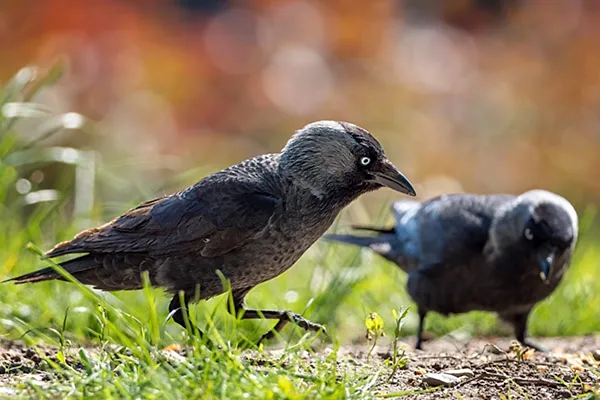
Scientific Name: Corvus monedula
Where is it Found: Europe and Western Asia
The Jackdaw is a small, sleek bird with glossy black feathers and a distinct grey nape. It’s one of the smallest species within the crow family, with a body length ranging from 34 to 39 cm. These birds are known for their intelligent and inquisitive nature and are often seen foraging in urban areas.
Interesting Facts:
- Jackdaws are known to recognise individual human faces and remember those who have treated them well.
- Their diet mainly consists of seeds, invertebrates, and fruits.
- Jackdaws are monogamous and form bonds that last for life.
2. Jamaican Tody
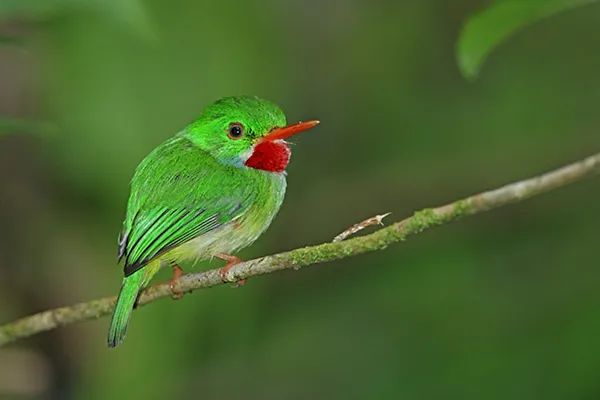
Scientific Name: Todus todus
Where is it Found: Jamaica
With vibrant green plumage and a striking red throat, the Jamaican Tody is truly a sight to behold. These birds are small, measuring only about 11 cm in length, and are known for their rapid and agile flight. They primarily feed on insects and sometimes even small fruits.
Interesting Facts
- The Jamaican Tody’s local name is “Rasta Bird” due to its vibrant colours reminiscent of Rastafarian culture.
- Their nests are caves dug into muddy banks or rotten wood.
- The call of the Jamaican Tody is a series of sharp notes, sounding like “pee-pee.”
3. Junco
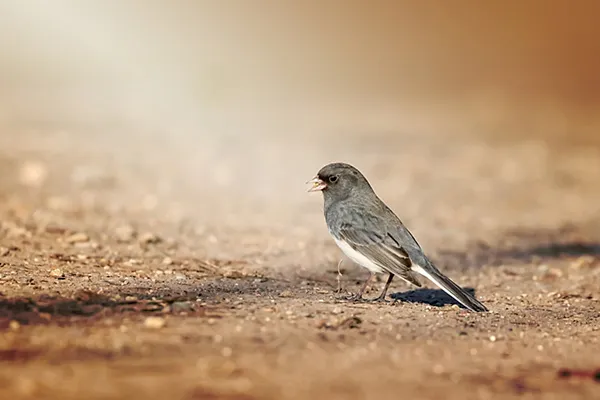
Scientific Name: Junco hyemalis
Where is it Found: North America
The Junco, often called the “snowbird”, is a small sparrow with varying plumage based on its subspecies. Generally, they have dark upper bodies, white bellies, and pink bills. They are often seen in gardens, especially during winter.
Interesting Facts:
- The name “Junco” comes from the Latin word for “rush” because they are often seen in rushy places.
- They often flip over leaves and debris to find insects to eat.
- In winter, Juncos flock together, sometimes mixing with other bird species.
4. Jabiru
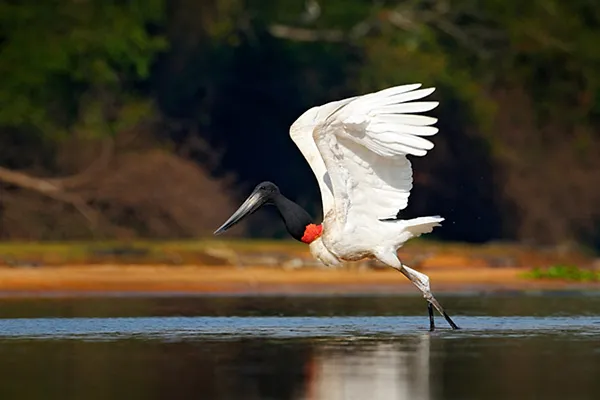
Scientific Name: Jabiru mycteria
Where is it Found: Central and South America
Standing tall at an average height of 1.4 meters, the Jabiru is one of the largest flying birds in the Americas. With a stark white body, a black head, and a reddish-pink band at the base of its neck, the Jabiru is simply majestic. It’s a stork that thrives in wetlands, feeding on aquatic animals.
Interesting Facts:
- The Jabiru is also called the “Black-necked Stork.”
- It often nests in tall trees; a single nest can be up to 5 feet wide.
- Their large bill helps them catch fish, molluscs, and even small mammals.
5. Jay
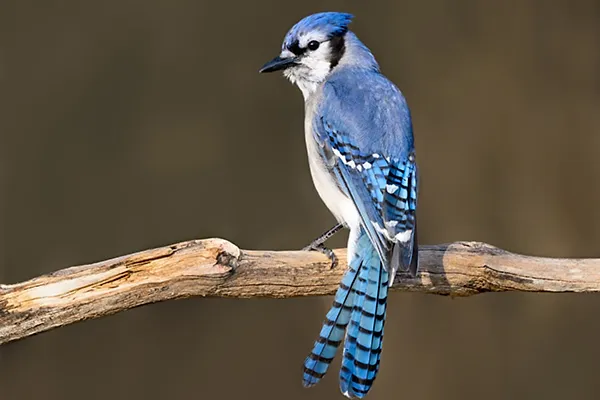
Scientific Name: Garrulus glandarius
Where is it Found: Across Europe, Asia, and North Africa
Jay is a member of the Crow family. It boasts a mix of pinkish-brown feathers, blue wing patches, and a black and white tail. It’s about the size of a jackdaw and is renowned for its loud, raucous calls, especially when alarmed.
Interesting Facts:
- Jays are known for mimicking the calls of other birds and animals.
- In autumn, these birds are frequently seen collecting and storing acorns for the winter months.
- Despite their vivid colouration, Jays can be surprisingly tricky to spot because of their secretive nature.
6. Japanese Sparrowhawk
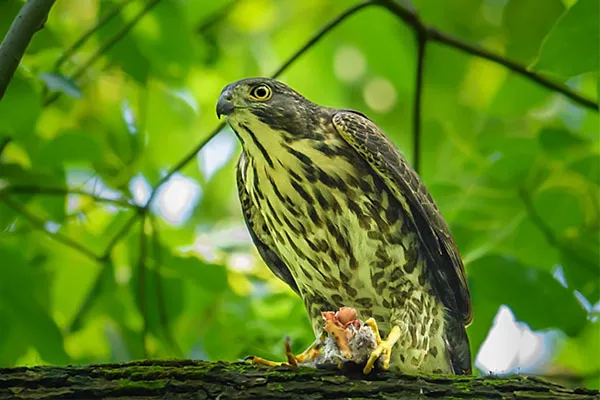
Scientific Name: Accipiter gularis
Where is it Found: East Asia
A small raptor, the Japanese Sparrowhawk, has a barred chest and belly, with males sporting a rufous chest and females a brown one. It has broad wings and a long tail, which it uses to manoeuvre swiftly through trees while hunting.
Interesting Facts:
- These hawks are migratory and travel long distances from Siberia to the Sundas.
- They primarily feed on birds and giant insects.
- During the breeding season, the male Japanese Sparrowhawk performs acrobatic flights to woo the female.
7. Junglefowl
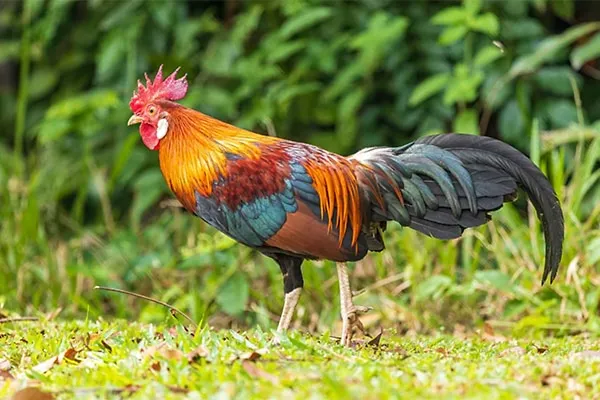
Scientific Name: Gallus gallus
Where is it Found: Across Southeast Asia and India
Junglefowl are ground-dwelling birds with striking plumage. Males have vibrant, glossy colours and an iconic red comb and wattles. They are often considered the wild ancestors of domestic chickens.
Interesting Facts:
- There are four known species of Junglefowl, with the Red Junglefowl being the primary ancestor of the domesticated chicken.
- Males have a distinct crowing call, which they use to establish territory.
- Junglefowl have well-developed spurs on their legs, which they use during fights with rival males.
8. Jaeger
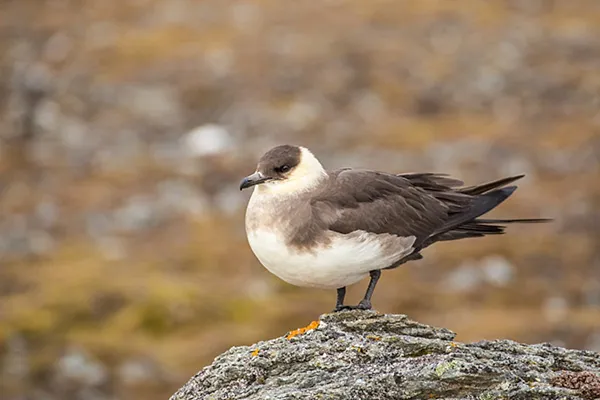
Scientific Name: Stercorarius spp.
Where is it Found: Polar and subpolar regions
Jaegers are seabirds known for their predatory and kleptoparasitic behaviour – they often chase other birds to steal their catches. These birds have sleek bodies and pointed wings, allowing agile flight manoeuvres.
Interesting Facts:
- “Jaeger” means “hunter” in German, apt for their predatory nature.
- They come in three species: the Long-tailed Jaeger, the Parasitic Jaeger, and the Pomarine Jaeger.
- During breeding season, Jaegers move to tundra habitats, primarily aquatic in the winter.
9. Juniper Titmouse
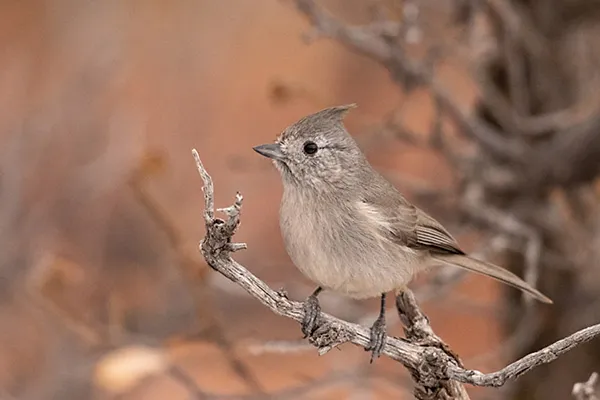
Scientific Name: Baeolophus ridgwayi
Where is it Found: Western North America
This tiny bird is characterised by its plain grey appearance and tufted crown. Juniper Titmice are active, hopping through juniper and pine trees while foraging for insects.
Interesting Facts:
- Despite their plain look, Juniper Titmice has a melodious song.
- They make their nests in tree cavities, often using old woodpecker holes.
- In winter, they switch to a diet mainly consisting of seeds and can be seen visiting bird feeders.
10. Jambu Fruit Dove
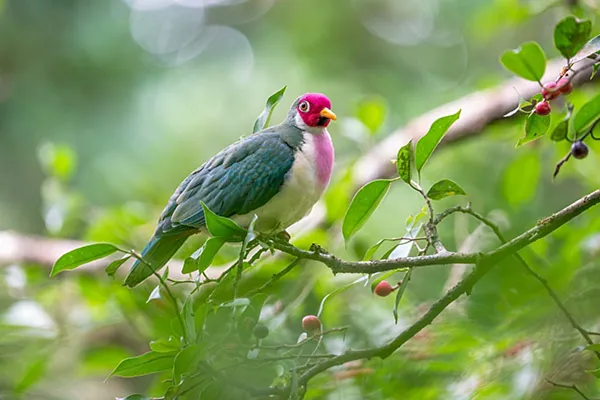
Scientific Name: Ptilinopus jambu
Where is it Found: Southeast Asia, specifically in the mangroves and forests of Thailand, Malaysia, and Indonesia
The Jambu Fruit Dove is a small and stunningly beautiful bird. Males have a crimson face, a white chest, and deep green plumage, while females are mostly green with a pale grey head. These doves are named after the jambu fruit, among their favourite foods.
Interesting Facts:
- Their distinct crimson face makes the males easily distinguishable.
- Apart from jambu fruits, their diet also includes berries and insects.
- Their soft, whistling flight is almost silent, making them elusive despite their vibrant appearance.
11. Jungle Crow
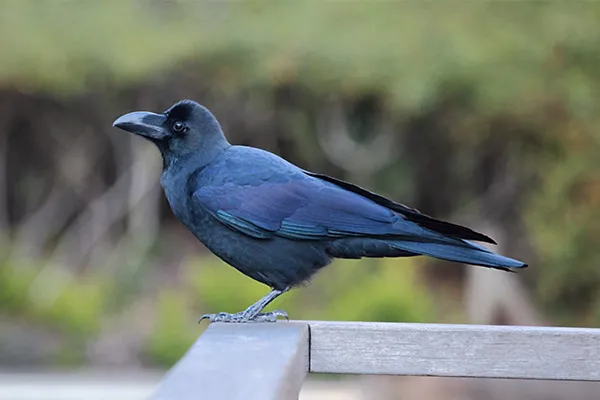
Scientific Name: Corvus macrorhynchos
Where is it Found: From the Himalayas down to Thailand and Sri Lanka in the South, and Japan in the East
Jungle Crows are large, robust crows with glossy black plumage. They possess a heavier bill compared to other crows, which aids in their versatile diet that ranges from fruits and insects to even small reptiles.
Interesting Facts:
- Jungle Crows use tools like twigs to extract insects from tree bark.
- They can adapt well to urban environments and are often seen foraging in city parks.
- These crows are vocal and have various calls, some of which can be loud.
12. Jack Snipe
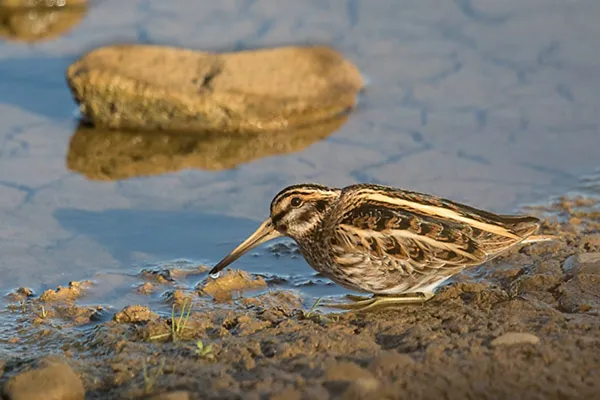
Scientific Name: Lymnocryptes minimus
Where is it Found: Across Europe and Asia, migrating to Africa and South Asia in winters
The Jack Snipe is a small and secretive bird, often unnoticed due to its excellent camouflage. It has a stocky build, a long bill, and short legs. Its plumage is mottled brown, helping it blend into marshy terrains.
Interesting Facts:
- Instead of flying when threatened, Jack Snipes often remain still, relying on their camouflage to avoid detection.
- They have a unique “bobbing” behaviour, resembling the movement of a sewing machine needle.
- During flight, they have a fast, zigzagging pattern, making them hard to target for hunters.
13. Japanese White-eye
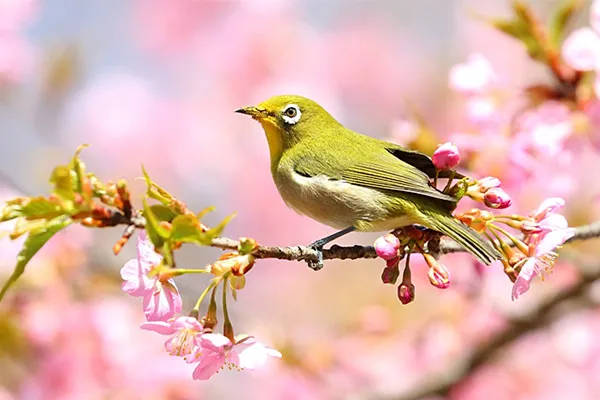
Scientific Name: Zosterops japonicus
Where is it Found: East Asia, primarily in Japan, China, and Taiwan
This tiny bird is characterised by its distinctive white eye ring, which gives the bird its name. The Japanese White-eye has a vibrant greenback, a yellow throat, and a grey belly. They are agile fliers and feed mainly on nectar and insects.
Interesting Facts:
- Japanese White-eyes have a sweet tooth and are known to steal sugar from cafes in urban areas.
- They play a vital role in pollination due to their preference for nectar.
- These birds are highly sociable and can be seen in mixed-species flocks.
14. Jacana
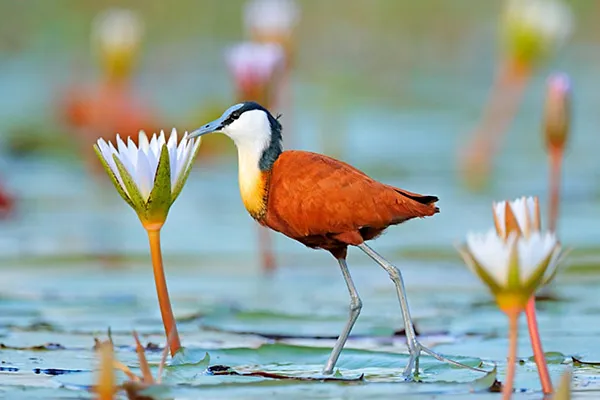
Scientific Name: Actophilornis
Where is it Found: Wetlands across tropical regions worldwide
Jacanas are often referred to as “Jesus birds” because they seemingly can walk on water, thanks to their long toes and lightweight bodies. These adaptations allow them to distribute their weight and walk atop floating vegetation. They have a striking appearance with long legs, long toes, and vivid plumage.
Interesting Facts:
- Female Jacanas are larger than males and practice polyandry, often having multiple mates.
- Males are primarily responsible for incubating eggs and caring for the young.
- Their large feet enable them to walk on lily pads without sinking.
15. Java Kingfisher
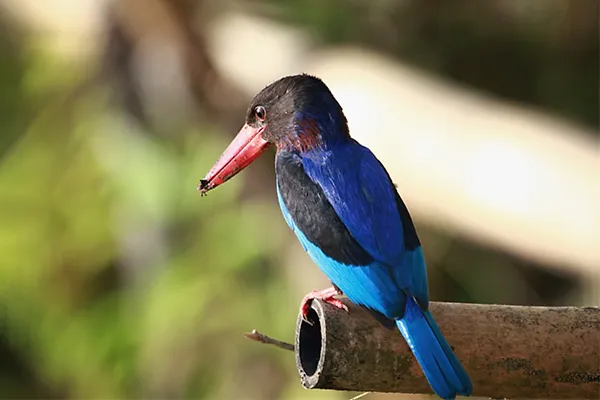
Scientific Name: Halcyon cyanoventris
Where is it Found: Island of Java, Indonesia
This stunning bird boasts a blend of blue, white, and cinnamon-coloured feathers. The Java Kingfisher primarily feeds on fish, insects, and small crustaceans. It is known for its sharp bill and its distinct, piercing calls.
Interesting Facts:
- Java Kingfishers have excellent vision, which aids in their hunting prowess.
- They are known to perch silently near water bodies, suddenly diving in to catch their prey.
- The vibrant blue on their wings and back shimmers brilliantly when exposed to sunlight.
16. Javan Hawk-Eagle
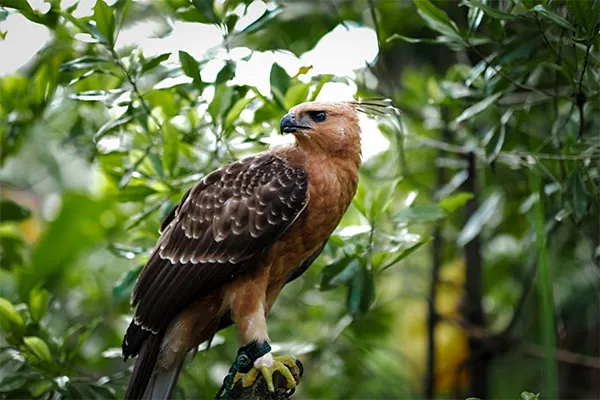
Scientific Name: Nisaetus bartelsi
Where is it Found: Forests of Java, Indonesia
An emblem of Indonesia, the Javan Hawk-Eagle is a medium-sized raptor with a prominent crest. It has a rich brown colouration with streaked white on its chest. This eagle soars high and swoops down with precision to catch its prey.
Interesting Facts:
- The Javan Hawk-Eagle is the national bird of Indonesia.
- Due to habitat loss and hunting, it’s now considered an endangered species.
- They primarily feed on birds, lizards, and mammals.
17. Javan Myna
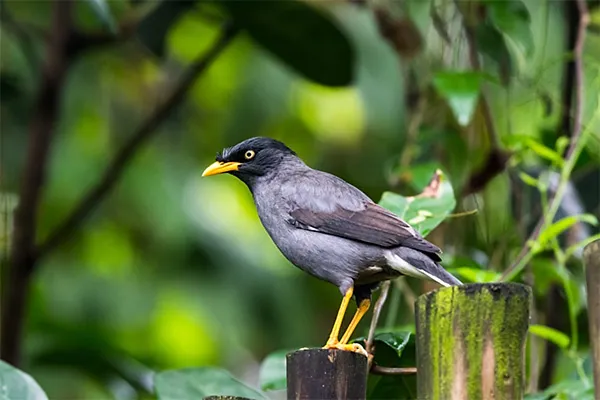
Scientific Name: Acridotheres javanicus
Where is it Found: Java and Bali, Indonesia
The Javan Myna, sometimes known as the White-vented Myna, is a stocky bird with a predominantly black body, a bright white underside, and yellow eye patches. They are often seen in urban areas and are known for their adaptability.
Interesting Facts:
- Javan Mynas are accomplished vocalists and can mimic a range of sounds.
- They are omnivores and often feed on human food scraps in urban settings.
- The Javan Myna is considered invasive due to its rapid spread and competition with native species.
18. Javan Trogon
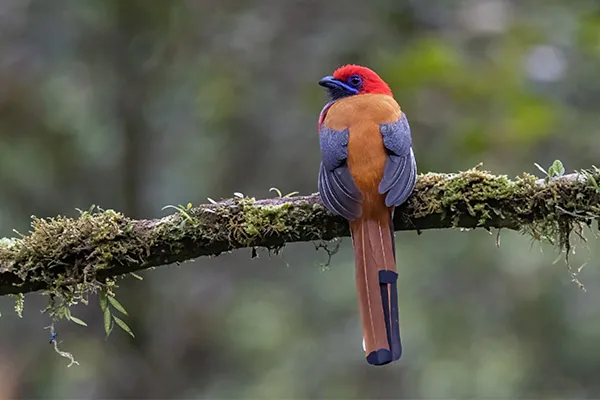
Scientific Name: Apalharpactes reinwardtii
Where is it Found: Montane forests of Java, Indonesia
The Javan Trogon is a visual treat, sporting a mixture of blue, green, and chestnut hues. Its bright colours and distinctive appearance make it a sought-after sight for birdwatchers. This medium-sized bird is tranquil and prefers staying hidden in the dense canopies.
Interesting Facts:
- Javan Trogons primarily feed on insects and occasionally fruits.
- Despite their vibrant colours, their secretive nature often makes them hard to spot.
- Sadly, the Javan Trogon is currently classified as vulnerable due to habitat loss.
19. Javan Plover
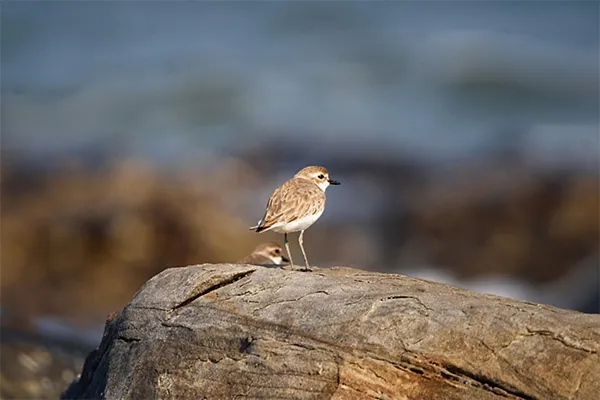
Scientific Name: Charadrius javanicus
Where is it Found: Coastal areas of Java, Indonesia
This small shorebird has a muted grey-brown plumage with a white belly, blending seamlessly with sandy beaches and mudflats. It can often be seen scurrying along the shore, searching for tiny invertebrates to feed on.
Interesting Facts:
- Their nesting sites are superficial scrapes in the ground, often lined with shells or pebbles.
- Javan Plovers are known to feign injury, luring predators away from their nests.
- Being coastal birds, they have a particular fondness for tidal zones where food is abundant.
20. Javan Owlet
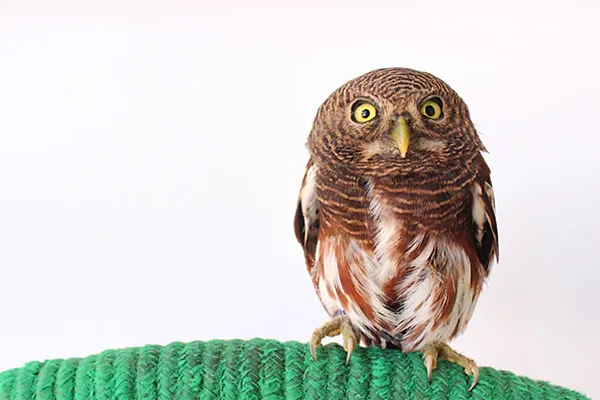
Scientific Name: Glaucidium castanopterum
Where is it Found: Forests of Java, Indonesia
The Javan Owlet is a petite bird of prey with greyish-brown plumage and piercing yellow eyes. It is active mainly during the twilight hours and hunts insects, small rodents, and sometimes even smaller birds.
Interesting Facts:
- The call of the Javan Owlet is a series of soft hoots, which can sometimes be mistaken for the sounds of insects.
- Unlike many birds, owlets have asymmetrical ears, which helps them pinpoint the accurate location of sounds.
- The Javan Owlet’s small size and nocturnal habits make it a rare sight, even for seasoned birdwatchers.
21. Javan Woodcock
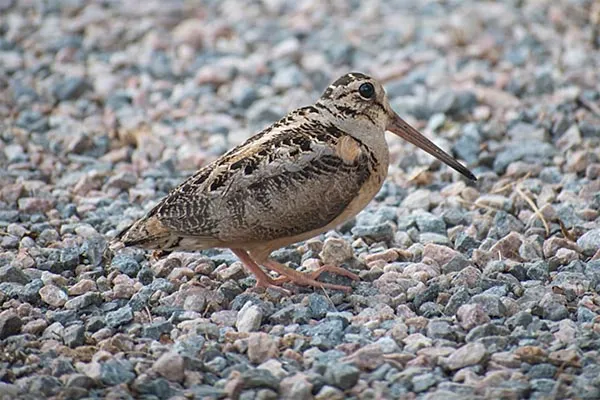
Scientific Name: Scolopax saturata
Where is it Found: Montane forests of Java, Indonesia
This elusive bird has a mottled brown plumage, which provides perfect camouflage against the forest floor. The Javan Woodcock has a long bill, which helps to probe the ground for worms and insects.
Interesting Facts:
- Javan Woodcocks are most active during dawn and dusk.
- They have a distinctive “roding” display flight, which involves flying in a repeating circuit while emitting a series of musical notes.
- The dense forests they inhabit and their crepuscular habits mean they are infrequently seen.
Other Birds Beginning With J
While we’ve explored a myriad of fascinating birds, starting with the letter J, it’s worth noting that this is just the tip of the iceberg. For those enthusiasts seeking a comprehensive understanding or birdwatchers wanting to expand their list, here’s an ensemble of other birds that begin with the jubilant letter ‘J’:
- Jack Snipe
- Japanese Night Heron
- Java Peafowl
- Japanese Grosbeak
- Japanese Pygmy Woodpecker
- Java Sparrow
- Jerdon’s Baza
- Jamaican Woodpecker
- Jungle Babbler
- Jambu Fruit Dove
- Jerdon’s Nightjar
- Jungle Nightjar
- Japanese Thrush
- Jamaican Spindalis
- Jungle Myna
- Javanese Munia
- Juniper Titmouse
- Japanese Wagtail
- Jerdon’s Leafbird
- Jamaican Oriole
- Japanese Bush Warbler
- Jerdon’s Courser
- Japanese Reed Bunting
- Jamaican Becard
- Jungle Prinia
- Japanese Accentor
- Jungle Owlet
- Jerdon’s Bushlark
- Jungle Bush Quail
- Jamaican Elaenia
- Javan Frogmouth
- Javan Coucal
- Japanese Robin
- Japanese White-eye
- Javan Hawk-Eagle
- Jungle Flycatcher
- Jamaican Vireo
- Jungle Crow
- Japanese Sparrowhawk
- Jerdon’s Chloropsis
- Javan Scops Owl
- Javan Whistling Thrush
- Jungle Martin
- Jamaican Euphonia
- Javan Cochoa
- Javan Banded Pitta
- Jerdon’s Tody-Flycatcher
- Japanese Quail
- Jamaican Crow
FAQs
1. How many bird species have names starting with the letter J?
While the exact number might vary due to taxonomic changes and regional differences, there are over 60-70 recognised bird species whose names start with the letter ‘J’.
2. Are all ‘J’ named birds found only in Java?
No, while many birds with names starting with ‘J’, like the Javan Hawk-Eagle or Javan Kingfisher, originate from Java, numerous ‘J’- named birds are found worldwide, from the Jackdaw in Europe to the Jamaican Tody in the Caribbean.
Birds that start with the letter “J” encompass a diverse and fascinating range of species, each with its unique charm and characteristics. From the wetlands of the tropics to the urban sprawls of cities, these avian wonders enrich our world, reminding us of nature’s incredible biodiversity.
Birds Names That Begin With (A to Z)
| A | B | C | D | E | F | G | H | I |
| J | K | L | M | N | O | P | Q | R |
| S | T | U | V | W | X | Y | Z |
Was This Article Helpful?
Parenting is a huge responsibility, for you as a caregiver, but also for us as a parenting content platform. We understand that and take our responsibility of creating credible content seriously. FirstCry Parenting articles are written and published only after extensive research using factually sound references to deliver quality content that is accurate, validated by experts, and completely reliable. To understand how we go about creating content that is credible, read our editorial policy here.























